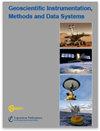欧空局 JUICE 飞行任务上标量磁强计的精度
IF 2.3
4区 地球科学
Q3 GEOSCIENCES, MULTIDISCIPLINARY
Geoscientific Instrumentation Methods and Data Systems
Pub Date : 2024-06-13
DOI:10.5194/gi-13-177-2024
引用次数: 0
摘要
摘要本文讨论了欧洲航天局(ESA)木星冰月探测器(JUICE)任务上的标量耦合暗态磁强计的精度。标量磁强计被称为 MAGSCA,是 J-MAG 仪器的一部分。MAGSCA 是一个光学全向标量磁强计,基于 87Rb D1 线超线性流形内的相干群体捕获(一种量子干涉效应)。测量原理仅基于自然常数,因此原则上不存在漂移,也无需校准。不过,技术实现会影响测量精度。最主要的影响是航向特性,即磁场强度测量值与环境磁场强度的偏差。这些偏差是传感器轴线与磁场矢量之间角度的函数,是磁强计测量原理的内在物理属性。需要对仪器的精度进行验证,以确保其符合 0.2 nT (1σ) 和 1 Hz 数据速率的性能要求。验证是通过位于康拉德地磁观测站(COBS)的梅里特线圈系统中的四个专用传感器方向进行的。线圈系统用于补偿地球磁场,并对传感器施加适当的测试场。本文提出了一种新方法,通过对测量数据进行数学模型拟合,并通过对 MAGSCA 性能要求的成功验证,将仪器的航向特性与线圈系统内的残余(偏移)磁场分离开来。本文章由计算机程序翻译,如有差异,请以英文原文为准。
Accuracy of the scalar magnetometer aboard ESA's JUICE mission
Abstract. This paper discusses the accuracy of the scalar Coupled Dark State Magnetometer on board the Jupiter Icy Moons Explorer (JUICE) mission of the European Space Agency (ESA). The scalar magnetometer, referred to as MAGSCA, is part of the J-MAG instrument. MAGSCA is an optical omnidirectional scalar magnetometer based on coherent population trapping, a quantum interference effect, within the hyperfine manifold of the 87Rb D1 line. The measurement principle is only based on natural constants; therefore, it is in principle drift-free, and no calibration is required. However, the technical realisation can influence the measurement accuracy. The most dominating effects are heading characteristics, which are deviations of the magnetic field strength measurements from the ambient magnetic field strength. These deviations are a function of the angle between the sensor axis and the magnetic field vector and are an intrinsic physical property of the measurement principle of the magnetometer. The verification of the accuracy of the instrument is required to ensure its compliance with the performance requirement of 0.2 nT (1σ) with a data rate of 1 Hz. The verification is carried out with four dedicated sensor orientations in a Merritt coil system, which is located in the geomagnetic Conrad Observatory (COBS). The coil system is used to compensate the Earth's magnetic field and to apply appropriate test fields to the sensor. This paper presents a novel method to separate the heading characteristics of the instrument from residual (offset) fields within the coil system by fitting a mathematical model to the measured data and by the successful verification of the MAGSCA performance requirement.
求助全文
通过发布文献求助,成功后即可免费获取论文全文。
去求助
来源期刊

Geoscientific Instrumentation Methods and Data Systems
GEOSCIENCES, MULTIDISCIPLINARYMETEOROLOGY-METEOROLOGY & ATMOSPHERIC SCIENCES
CiteScore
3.70
自引率
0.00%
发文量
23
审稿时长
37 weeks
期刊介绍:
Geoscientific Instrumentation, Methods and Data Systems (GI) is an open-access interdisciplinary electronic journal for swift publication of original articles and short communications in the area of geoscientific instruments. It covers three main areas: (i) atmospheric and geospace sciences, (ii) earth science, and (iii) ocean science. A unique feature of the journal is the emphasis on synergy between science and technology that facilitates advances in GI. These advances include but are not limited to the following:
concepts, design, and description of instrumentation and data systems;
retrieval techniques of scientific products from measurements;
calibration and data quality assessment;
uncertainty in measurements;
newly developed and planned research platforms and community instrumentation capabilities;
major national and international field campaigns and observational research programs;
new observational strategies to address societal needs in areas such as monitoring climate change and preventing natural disasters;
networking of instruments for enhancing high temporal and spatial resolution of observations.
GI has an innovative two-stage publication process involving the scientific discussion forum Geoscientific Instrumentation, Methods and Data Systems Discussions (GID), which has been designed to do the following:
foster scientific discussion;
maximize the effectiveness and transparency of scientific quality assurance;
enable rapid publication;
make scientific publications freely accessible.
 求助内容:
求助内容: 应助结果提醒方式:
应助结果提醒方式:


